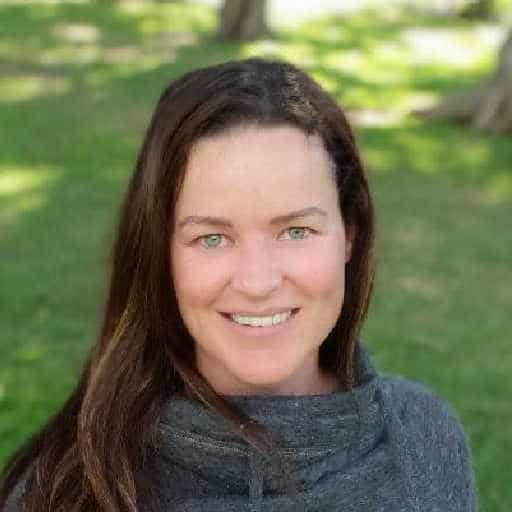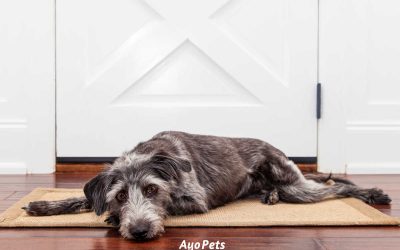My dog loves begging for berries and bananas while I make myself smoothies. I’ve often wondered if the fruit would do him any good or any harm, so I did a little digging to find out if dogs can eat fruit.
It turns out…
Dogs can safely eat most fruits in small quantities as occasional treats, such as raspberries, pineapple, or mango, but treats should never be more than 10% of a dog’s daily calories. Always remove fruit cores, pits, rinds, stones and seeds, and chop hard fruit into small pieces before feeding it to a dog.
But did you know that there is no nutritional reason to feed a dog fruit other than fruit being a tasty treat to enjoy? Some fruits are even toxic and may make a dog very sick or kill them. Even though fruits are packed with vitamins, minerals, antioxidants, and other goodness, dogs on a balanced diet do not need to eat fruit at all (or these dog-friendly vegetables).
There are some things to know before feeding a dog fruit, if you want to avoid choking or making a dog sick – if in doubt, it’s best not to give your dog any fruit.
Here are the basic rules of thumb to follow when feeding fruit to a dog…
How to feed fruit to a dog
Introduce fruit slowly to your dog’s diet by giving your dog a small piece of fruit, then watch to see if the dog shows any side effects such as diarrhea, vomiting, a sore stomach, or flatulence over the next day or two.
A dog might be fine with one type of fruit but react badly to another.
Dogs can only eat a little fruit at a time, such as a slice or two of a peeled apple – never the whole apple. Medium and large breeds will be able to eat more fruit than smaller breeds.
The healthiest fruits to feed your dog are plain pumpkin, coconut meat and cranberries.
Many fruits can be frozen to make a refreshing treat during the warmer months.
Most fruits are high in sugar, so it’s better not to make fruit a staple in your dog’s diet, especially if your dog has diabetes.
Most fruits are also high in fiber, which may cause bloating, diarrhea, or vomiting if too much fruit is eaten at one sitting.
Always wash fruit before giving it to your dog, especially if your dog is eating the skin.
Never give a dog rotting or rotten fruit as it probably contains ethanol, which is toxic to dogs.
Never give a dog seeds, pits or stones from fruit as many contain cyanide, which is toxic to dogs.
Never give a dog canned or preserved fruits as these contain a lot of sugar and preservatives, which may cause weight gain and hyperactivity.
Large pieces of hard fruit can be a choking hazard, so be sure to watch your dog and take the fruit away when it gets too small, or cut the fruit into very small pieces that cannot choke your dog if he/she swallows the piece of fruit whole.
Always consult your veterinarian for advice before adding fruit to your dog’s diet. The list below is for information purposes only. Dogs do not need to be given fruit if they are on a balanced diet, and too much fruit can do more harm than good, particularly if your dog has health issues such as diabetes.
List of fruits dogs can eat

Here’s an alphabetical list of fruits that dogs can eat in moderation, with some notes on how to serve them:
FRUITS DOGS CAN EAT | HOW TO FEED FRUITS TO DOGS |
Apples | Dogs can safely eat one or two slices of a peeled apple. Always remove the skin and seeds before cutting a slice or two for your dog. Or cut some small apple chunks to use as a training treat. Never feed an apple core or apple seeds to your dog as these can choke your dog or poison him/her. |
| Apricots | Dogs can eat a small piece of apricot at a time. Too much apricot may cause vomiting and diarrhea, so never give a dog a large piece to start with. Remove the stone before giving apricot to your dog, as it contains cyanide and can be toxic. Don’t feed dogs preserved apricots as these have very high sugar levels, which can cause hyperactivity and obesity in dogs. |
| Bananas | Dogs can safely eat some banana every day. Peel the banana and chop it into pieces before giving it to your dog. A large dog can eat up to half a banana per day, while small dogs should be given no more than two to three slices of banana a day. To make a cooling treat for your dog, cut a banana into slices and put the slices in an ice tray in the freezer. On a hot day, give your dog some frozen banana slices to chew on. This also stops the dog from making a mess when they eat bananas. |
| Blackberries | Dogs can safely eat blackberries in moderation. A small dog should be safe eating two or three blackberries and a larger dog can eat up to six blackberries at a time. More than this may give the dog diarrhea or cause vomiting. |
| Blueberries | Dogs can eat blueberries as an occasional treat. A small dog can be given two to three blueberries and a larger up to six blueberries at a time. Blueberries offer many healthy antioxidants, but can cause vomiting or diarrhea if a dog eats too many in one go. |
| Cantaloupe / Rock Melon / Sweet Melon / Spanspek / Musk Melon / Mush Melon / Persian Melon | Cantaloupes are safe for non-diabetic dogs in moderation. Remove the seeds and rind before feeding as they are a choking hazard. Also, the rind may get stuck in the dog’s digestive tract. Cut the fruit’s flesh into small pieces that won’t choke your dog if it swallows the piece whole. Then give your dog two or three pieces of cantaloupe to enjoy. Cantaloupes have a lot of water in them and make a refreshing snack on a hot day, especially cold from the refrigerator or frozen in ice cubes. Keep an eye on your dog to make sure there are no side effects, such as flatulence, vomiting, or diarrhea. If there are side effects, don’t feed your dog cantaloupe again. These melons are loaded with vitamins A and C, along with other nutrients. But dogs do not need nutrients from fruit if they are eating a balanced diet. Also, there are about 13 grams of sugar in 1 cup of cantaloupe, so don’t feed this fruit to your dog often and don’t give cantaloupe to your dog at all if your dog has diabetes. |

| Cherries | The flesh of one or two fresh cherries is generally safe for dogs to eat, but use caution when giving your dog cherries: Dogs should never eat cherry pits (the hard seeds inside the fruit), stems or leaves as these contain cyanide and may be toxic to dogs. Also, the pit may block the intestine, especially in smaller dogs. Based on these risks, it’s probably better not to give your dog any cherries to eat. Dogs can safely eat one or two dried cherries. These should be an occasional treat and not a regular part of your dog’s diet. Dogs cannot eat maraschino cherries. These are soaked in sugar and are very unhealthy for a dog to eat. If a dog has eaten more than two cherries or cherry pits, look for the following symptoms: – Constipation – Not eating – Vomiting – Heavy breathing – Dilated pupils – Red gums It can take up to 24 hours for these symptoms to show. If your dog shows these symptoms, it’s best to take him/her to a vet to be checked for cyanide poisoning or an intestinal blockage. |
| Coconut | Dogs can safely eat a small block or two of raw coconut flesh/meat. Also, a teaspoon of coconut oil can be added to a dog’s meal. But coconut is very rich and too much may cause bloating, diarrhea, or vomiting. Always remove the hard shell before feeding coconut to a dog, as this shell is a choking hazard. Coconut is a fairly healthy snack for dogs and is a great option to choose when looking for fruits to feed your dog. Coconut meat and coconut oil both have anti-inflammatory and anti-viral properties. A little coconut may go a long way in moisturizing a dog’s dry skin and brittle hair. Coconut may also help with healing cuts and wounds, along with fighting off infections. If your dog has brittle hair and dry skin, it may be a sign of too much washing. Click HERE to find out how often to bathe your dog for optimum health. |
| Cranberries | Small dogs can safely eat one or two cranberries a day as a treat. Larger dogs can eat a few more at a time. These cranberry treats may be raw, dried, or cooked. Cranberries have many health benefits for dogs. But cranberries are high in fiber and may cause diarrhea or vomiting if a dog eats too many at a time. Don’t ever give your dog a cranberry supplement or pill as these are not safe for dogs. Cranberries are not toxic to dogs and any side effects from eating too many should pass within 24 hours. Because cranberries aren’t dangerous to dogs, they make a great occasional fruit treat. Cranberries may help your dog to fight a bladder infection, remove tartar from the dog’s teeth, and fight bacteria. |
| Figs | Most dogs can safely eat the flesh of one or two figs per week. Other dogs may react badly to eating figs and should avoid figs altogether. Figs are high in fiber and may give any dog diarrhea or cause vomiting if too much is eaten at one time. Dogs should never eat or touch a fig plant, especially the leaves. Remove the skin before feeding the soft inner flesh to your dog as the rind is a choking hazard or may block the dog’s digestive tract. Figs are not toxic to dogs but can be an irritant for some. A dog that shows symptoms or a reaction after eating a fig’s flesh should recover within a day or two. Dogs that do react to the irritants in figs may: – Drool heavily – Vomit – Have diarrhea |
| Goji Berries / Wolf Berries | Dogs can safely eat a few goji berries as a treat. Small dogs should have no more than one or two berries at a time, while bigger dogs may be able to handle five or six berries. These can be fresh or dried gojis. But goji berries are high in sugar and should only be an occasional treat for healthy dogs. Diabetic dogs should never eat goji berries. As with most fruits, eating too many goji berries at once may cause vomiting or diarrhea in dogs. Goji berries are not toxic to dogs and any symptoms or side effects after eating goji berries should disappear within a day or so. |

| Honeydew Melons | Honeydew melons are safe for non-diabetic dogs in moderation. Cut the fruit’s flesh into small pieces that won’t choke your dog if he/she swallows a piece whole, then limit your dog to two or three pieces a day. Always remove the seeds and rind as they are a choking hazard. Also, the rind may get stuck in the dog’s digestive tract. Honeydew melons have a lot of water in them and make a refreshing dog treat on a hot day, especially cold straight from the refrigerator or frozen in ice cubes. These melons are high in sugar, so don’t feed this fruit to your dog often and don’t give any honeydew melon to a diabetic dog. |
| Kiwi Fruit | Dogs can safely eat a one or two slices of kiwi fruit per day. Leave the skin on if your dog is a bigger breed and likes to eat it, but remove the skin and seeds for smaller dogs to prevent choking or intestinal blockages. Don’t ever feed a whole kiwi fruit to a dog as the dog might choke. The easiest way to get the flesh out of a kiwi fruit for a small dog is to cut the fruit in half and scoop the flesh out of each half with a spoon. For bigger dogs, simply cut thin slices with a knife and share one or two with your dog. As with most fruits, too much kiwi fruit may cause vomiting and diarrhea in dogs. |
| Mangoes | Dogs can safely eat a little mango flesh per week. Large dogs should get no more than one-quarter cup of mango at a time, and small dogs half of this. Remove the outer skin and pit before feeding mango to a dog, as these are a choking hazard or may block the intestine. Also, mango pits contain cyanide which may be toxic to dogs. Freeze small blocks of mango to make tasty, refreshing treats for your dog during the warmer months. Mangos are high in sugar and should only be an occasional treat for healthy dogs. Dogs with diabetes should never eat mango. Because of the high sugar and fiber content in this fruit, a dog that eats too much mango may experience bloating, vomiting, and/or diarrhea. |
| Mulberries | Dogs can safely eat one or two ripe mulberries at a time as a treat. But unripe mulberries and too many mulberries usually give a dog diarrhea and cause vomiting. These berries are non-toxic to dogs and any symptoms should go away within 24 hours. |
| Nectarines | Dogs can safely eat small amounts of fresh nectarines as an occasional treat. Small dogs can eat one or two slices, while larger dogs may eat four or five slices at a time without any side effects. Nectarines are high in fiber and sugar, so eating too much may cause bloating, diarrhea, vomiting, and/or blood sugar fluctuations. Never give a dog a nectarine pit as it contains cyanide and can be toxic to dogs. It is also a choking hazard or may get stuck in the dog’s digestive tract. Dogs should never eat canned nectarines as they contain unhealthy preservatives and sugar. These ingredients may make your dog hyperactive and overweight. |

| Oranges | Healthy small and medium-sized dogs can safely eat one or two sections of orange flesh at a time. A large dog may eat up to three sections at a time. Remove the peel, pith and seeds from the orange before feeding orange to your dog as these can be dangerous. They are also a choking hazard or can get stuck in a dog’s digestive tract. The pith is the white film under the peel that surrounds the flesh. This should not be given to dogs to eat. Oranges contain a lot of sugar and acid, which may make a dog vomit or cause bloating and/or diarrhea if a dog eats too much at a time. Because of the high sugar content, oranges should never be given to overweight dogs or dogs with diabetes. Oranges are not toxic to dogs and any side effects from eating too much of an orange should go away within a day. |
| Peaches | Dogs can safely eat one or two chunks of a fresh peach as a special treat. Remove the peach pit before feeding your dog as it is a choking hazard and may be toxic. Never feed preserved or canned peaches to a dog. Peaches are high in fiber and sugar, so eating too much may cause bloating, diarrhea, and/or vomiting. A peach pit, or stone, and a peach plant contain cyanide, which can be toxic to dogs. The only part of a peach that is safe for a dog to eat is the fleshy fruit and skin. And even this needs to be eaten in moderation to avoid an upset tummy. Dogs should never be given canned or preserved peaches as they contain unhealthy preservatives and sugar. These ingredients may make your dog hyperactive and/or overweight. |
| Pears | Small dogs can safely eat a thin slice of pear and larger dogs can eat up to two slices at a time. Due to the high sugar and fiber content in pears, this fruit should be an occasional treat and not part of a dog’s daily diet. Eating too much at once can cause vomiting, bloating, and/or diarrhea. Because pears are a hard fruit, they can be a choking hazard or get stuck in a dog’s digestive tract if a large piece is swallowed. Cut pear into thin slices or bite-sized pieces, and keep an eye on your dog when feeding pears as a treat. Always remove the core and seeds before feeding pear to a dog. The seeds contain small traces of cyanide, which can be toxic to dogs. Also, the core and seeds can choke a dog or get stuck in their digestive tract and require veterinary attention. Never feed a dog canned or preserved pears because they have a high sugar and preservative content, which could make your dog hyperactive or gain weight. |
| Pineapple | Small dogs can safely eat one chunk of raw pineapple. Medium-sized dogs can eat two and large dogs three chunks at a time. Always remove the hard skin and the core through the center of the pineapple first. Because of the high sugar content, it’s best to not feed a dog any pineapple. If you do, do so on rare occasions. Dogs should only ever be given raw pineapple and never canned or preserved pineapple. Pineapples have a lot of sugar and fiber, so eating too much may cause bloating, vomiting, and/or diarrhea in dogs. Pineapple is not toxic and any side effects from eating too much should go away within 24 hours, unless the dog has eaten the core or skin and this is stuck in the digestive tract. If this is the case, then the dog requires medical attention. An old wives’ tale is that feeding your dog pineapple will stop your dog from eating poop. This is not true and is not a reason to feed a dog pineapple. |
| Plums | Dogs can safely eat one or two slices of raw, fresh plum on occasion. Leave the skin on if your dog is a bigger breed and likes to eat it, but remove the skin for smaller dogs to prevent choking or internal blockages. Don’t ever feed a whole plum or a plum pit as the dog might choke or get a blockage in the digestive tract. Plum pits, stems and leaves contain cyanide. If a dog eats several pits or a plum plant, it could become very ill and die. If your dog has eaten any of these, look for the following signs of poisoning and take your dog to the vet immediately: – Bright red gums – Dilated pupils – Difficulty breathing – Panting Plums are high in sugar and should not be fed often as a dog treat. Dogs with diabetes should never eat plums due to the high sugar content. As with most fruits, if a dog eats too much of a plum’s flesh in one go there may be gastric side effects, such as bloating, vomiting and diarrhea. |
| Pumpkin | Dogs can safely eat plain cooked or canned pumpkin every day. Feed a dog about 1 teaspoon of pumpkin for every 10 lbs of dog weight. So, a female Labrador that weighs 60 lbs can eat 6 teaspoons of pumpkin at a time. Never give a dog any pumpkin with salt, pepper, or any other additives. Never give a dog the hard outer pumpkin skin or seeds. These are a choking hazard and may block the dog’s digestive tract. Also, never give a dog canned pumpkin pie as it may contain xylitol which is toxic to dogs. Pumpkin has many health benefits for dogs. Just add 1-4 tablespoons of plain, cooked pumpkin to a dog’s meal to stop diarrhea, stop constipation, help with weight loss, and give your dog a shiny coat. |

| Raspberries | Dogs can safely eat washed raspberries now and then. Small dogs should be limited to about one-quarter cup, medium breeds to half a cup, and large breeds to no more than 1 cup of raspberries at a time. Although raspberries are fairly low in sugar, eating too many will upset a dog’s stomach. Eating some fresh or frozen raspberries as a treat should be safe for dogs. But eating a very large amount may spike and then drop a dog’s sugar levels and require veterinary attention. If your dog has eaten a lot of raspberries, look for the following symptoms of hypoglycemia (low blood sugar): – Twitching in the muscles – Slow movements – Sleepiness – Dilated pupils – Loss of appetite |
| Strawberries | Dogs can eat fresh, washed strawberries in moderation. Give no more than one strawberry to a small dog, two to three strawberries to a medium-sized dog, and three to four strawberries to a large dog at a time. Chop, puree or mash strawberries before giving them to a dog, to prevent choking. Don’t ever give canned strawberries to a dog, especially strawberries in syrup. These are full of sugar and preservatives and are not healthy for any dog to eat. Like other fruit, strawberries contain sugar. Some dogs might react badly to the sugar in strawberries, especially if they eat too many of these delicious berries. If a dog does have any negative reactions, don’t feed him/her strawberries again. Too many strawberries could cause bloating, a sore stomach, vomiting, and/or diarrhea in a dog. |
| Tangerines / Mandarin Oranges | Dogs can safely eat two to three slices of a fresh tangerine. But tangerines are not part of a dog’s natural diet and should not really be included in it. Tangerines contain both sugar and fiber, so if your dog does eat some of this fruit, he/she might get a sore tummy, bloating, diarrhea, or start vomiting. Tangerines are not toxic to dogs and any side effects should resolve within a day or so. If your dog is on a balanced diet, then feeding him/her tangerines will not have any nutritional benefit and may just cause an upset stomach. |
| Watermelon | Dogs can safely eat pink watermelon flesh, but never the hard outer rind or seeds as these are choking hazards or could block the digestive tract. Limit small dogs to one-quarter cup, medium-sized dogs to half a cup, and large dogs to one cup of chopped watermelon flesh at a time. Any more than that and the dog may get diarrhea or start vomiting. Watermelons are high in sugar and should be a very occasional treat. If you do want to give watermelon to your dog, leave about 6 weeks between these sweet treats. |






